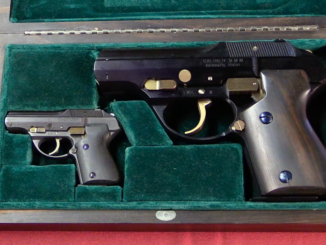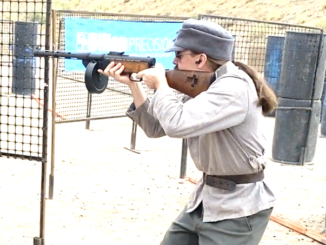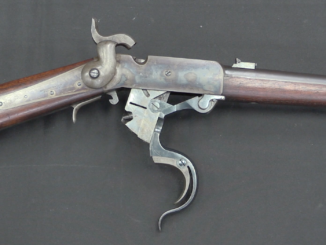The STG-M1A certainly looks and feels like a Thompson, but does it shoot like a Thompson? Let’s find out!
Related Articles

Prototype
Norton DP-75: Titanium Plus German Police Pistol
This pistol is something of a mystery – its design comes from the experimental Mauser HsP of the mid 1970s. It uses a short recoil system with a pivoting locking block vaguely like a P38, […]

Competition
Full Auto Suomi in the 2021 AZ PCC Championship
The Arizona PCC (Pistol-Caliber Carbine) Championship is a 10-stage competition held every year at the Rio Salado Sportsman’s Club in Mesa, AZ. It is normally only open to semiauto carbines, but I was able to […]

Single Shot Rifles
America’s First Metallic Cartridge: The Burnside Carbine
The Burnside carbine was originally invented by Ambrose Burnside – the man who would later command the Army of the Potomac and after whom sideburns would be named. Burnside came up with the idea while […]

Hi Ian 14k is less than “Thompson prices “but still steep. Also during the war I believe there was a full auto only Thompson manufacted . I know I looked at one in shotgun news in 1988 4k, yea I should of.
I have heard stories for years that if you held a Thompson on it’s side, the climb would work to your advantage and shoot a horizontal group, is that true?
During WWII, my uncle was taught to do that.
Thanks William,
My father was a firearms trainer at Fort Riley Kansas and he never mentioned that, but he claimed that he could empty a magazine by simply holding his left hand as a support without gripping the forearm. Sort of like forcing a U with your thumb and the palm of your hand. He claimed that the weight of the gun would bring it back down before the next round went off. The only opportunity I had to shoot one, it was fitted with the vertical grip so I couldn’t test the theory☹️. Has anyone else tried this?
A MG rental range in Las Vegas instructed me to hold the Thompson with the toe of the stock planted in my shoulder pocket instead of planting the full buttplate. It was peculiar way to shoulder the Thompson, but it did stop the buttlplate from sliding off my shoulder during fire.
Maybe the oddities of the Thompson buttstock and fire-controls aren’t really bad, as much as they are just different?
I have a 7 pound airsoft replica of an M1 Thompson, and I’ve been fooling around with different ways of manipulating it, and I’ve come to some hypotheses of how the Thompson may have been intended to be handled.
Recall that the original Thompson prototype “trench broom” didn’t even have a buttstock. So in the context of WW I trench warfare, imagine how handling a stocked Thompson might have been intended. I suspect the Thompson buttstock was not shaped for conventional shouldering while in the standing-position.
Instead the buttstock seems to be shaped for shouldering while in the prone-position. While in the standing-position Instead of shouldering the Thompson, choking up by trapping the cheek of the buttstock back and up into the armpit, might be good for controlling full auto-fire while assaulting a position at close range. The deep droop of the stock places the boreline closer to the line of sight for improved spray and pray?
In the prone-position with elbows planted, the cheek weld and shouldering of the butt are much more natural compared to the Thompson in standing-position. In the prone I find my left hand falls into grasping the magazine, with my left thumb in contact with the underside of the trigger guard. That left-hand position revealed to me operation of the magazine release lever that is easy and intuitive.
During magazine changes, the right-handed shooter supports the Thompson with the right hand, the left hand grasps the empty magazine which places the left-thumb in a natural position to use magazine release lever while withdrawing the magazine. I also suspect manipulation of the fire-controls were intended from the left-hand of a right handed shooter.
Alternative furniture for Thompson sub-machine gun was tested in 1942, which was supposed to probably lessen muzzle climb, see 1st photo from top https://strangernn.livejournal.com/2140841.html
I do not know what conclusions were
Daweo, I bow to your amazing and extensive knowledge. I don’t even care if you’re finding this stuff as Ian posts it, the fact that you can pull up these bits of information at all is incredible!
I swear, you and a couple of other people that post things on here in response are more than half the value of the site…
“…I don’t even care if you’re finding this stuff…”(С)
https://www.forgottenweapons.com/experimental-thompson-stock/
The rest is done by Google search for pictures.
I agree…..
Ian Thompsonius is shooting and Daweo Literatus is searching.
I think a lot of the Thompson’s design stems from the fact that the gun was “first past the post” for submachineguns in general, and they really didn’t even have all the basics worked out. The fact that the weapon lasted as long as it did is a testimony to how close they were to “getting it all right”.
Guy I knew who did a lot of subgun work for police training always said that the Thompson was his favorite weapon to use, but that it wasn’t his favorite for any reason you’d think, like the ergonomics or the actual characteristics of the weapon. What he liked best about it was that the sight of him with it usually did more of job of intimidation and de-escalating situations than any other gun he’d actually used as a police tactical officer. Nobody wants a burst of .45 in the chest, as he put it…
I think he phrased something else about the Thompson like this, that more than half the value of the gun wasn’t in how well it could be used, but in the fact that once it was deployed, it didn’t often get used because of the intimidation factor. He’d had to shoot people with the M1 carbine, the Winchester 94, and revolvers, but never once did he have a situation where someone saw him with a Thompson and still wanted to play games with him… Something else he said was that the Thompson “…just looks mean…” from the muzzle-view. He especially liked the drum magazine for those situations.
Of course, that was talking to him about his career in the 1950s, ’60s, and ’70s, while we were in the late 1980s, so your mileage may vary, and people’s perceptions of the gun may have changed.
“(…)sually did more of job of intimidation(…)”
This means it was used according to advert, see 1st image from top http://www.gunclassics.com/m1928.html
Here’s the Gun
that Bandits Fear Most!
—the
T h o m p s o n
Anti-Bandit Gun
Kirk, that sounds very plausible. The effect of Thompsons as shown in movies is always most impressive. Due to a lack of real gunfight experience in most cases, movies doubtless have had a big impact on the attitude on both sides of the law.
Chuck Taylor, who used a Thompson in Vietnam, recommended tucking the stock under the armpit as Brad suggests. Also, the original had a Cutts compensator which would have resulted in less muzzle climb, as would have the weight of a 50 round (or 100 round) drum magazine. This was in the era when the service rifle was .30-06, and compared to a rifle firing that the muzzle climb/recoil of a Thompson would have been comparatively mild. In the 1910’s was there an expectation of anyone anywhere that a combat arm would have no muzzle climb?
Regarding the Thompson in general (and not in response the thoughtful post by Brad), this was a first generation SMG. And for being a first generation SMG, not bad at all. When WWII started, well, that was what was available at the time and so that was what the country went to war with despite being outdated and expensive. Between the wars ordinance had focused on the more important modernization of rifles. Recognizing the short comings of the SMG, US ordinance replaced the Thompson before the end of the war. Negative comparisons of a SMG designed in the 1910’s, with subsequent generations of SMGs decades later is kind of missing the point as to what it was at the time.
“(…)And for being a first generation SMG, not bad at all.(…)”
Also, in 1930s when George Hyde was designing his sub-machine gun (now known as The Hyde Model 35 Submachine Gun) it was (shape-wise) greatly influenced by Thompson https://www.smallarmsreview.com/display.article.cfm?idarticles=1697
so stock of such shape was apparently deemed viable enough to be incorporated in weapon designed from scratch.
The influence of the 1921 Thompson SMG is also clearly seen in the stock design and pistol-grips of the WWII Owen SMG of Australia.
(Some minor follow ups to my initial Thompson handling hypotheses.)
The odd layout of the Thompson also seems well suited to the following shooting positions:
The droop of the buttstock works well in the prone supported position, such as shooting from a foxhole (or barrier shooting positions such as from a widowsill). Sort of like a clubfoot stock of an RPK. With the Thompson forestock supported by a sandbag, the left hand grasps the underside of the buttstock just forward of the sling loop, then push the Thompson forward until the sandbag contacts the magazine. This is a very stable position, also very low profile because of the short barrel protrusion and the low height of the sights over the bore, and quick to assume and to conceal.
For indoor shooting, I’ve seen a modern technique that has a combatant choke up on an M16 rifle and hold the buttstock above and behind the shoulder. I’ve also seen a modification of that technique applied to conventionally stocked shotguns, with the shotgun rotated to the left and the stock resting on top of the shoulder, which brings the boreline very close to the line of sight. The great droop of the Thompson buttstock in conjunction with the pistol grip works very well with that shotgun technique.
One major reason for the muzzle climb is that most of the weight is in the rear, with very little in front of the chamber. Combined with the high axis, that’s simple physics. Not even physics, really: more simple geometry. Archimedes knew about levers.
The stability of automatic weapons is NOT determined by the layout alone.
All these dynamic processes depend on too many factors.
Ultimately, it all depends on the stock of calm and patience that is needed to determine the optimal configuration of the device, through the scientific method “at random”.
In this sense, the throwing of the designers of Tommy’s options is very evident.
When “minor” design changes involved dramatic changes in characteristics like rate of fire and stability, which are determined by the harmonics of the weapon itself.
In a general sense, Thompson’s SMG is a vivid example of luck at all stages of its existence.
Because (objectively) it was supposed to be a complete failure, but the coincidence of circumstances made it relevant and successful.
Simply, there was nothing else at that time.
Overall, the situation is not new.
A similar story happened with the Kalashnikov assault rifle and many others, even now.
Especially now. When devices are adopted not with the best characteristics, but which can be obtained easier and faster.
Yeah, try explaining how the M14 in full auto can barely hit a barn at 200 yards, then. No matter how strong you are, there’s no denying that the rifle bucks around too much because of the dynamics resulting from the stock layout, the nasty recoil impulse from cycling, and resulting torqueing about that happens with people not used to being kicked in the shoulder at 700 rounds-per-minute suddenly flinching.
I like all the stemple stuff, thanks Ian
Glad to see a video on these, a buddy has one and it is a nice gun. I’ve got a 1928AC made in late 41. I’m by no means an expert but do have many tens of thousands of rounds through mine.
Having said that, it always pains me that no one seems to know the technique to insert or remove a thompson mag. Everyone just tries to shove it straight in and then complains about how difficult it is. Like has been mentioned, it is a first generation gun and as such a few things are just a bit “different.”
Grab the mag in your left hand and stick your thumb up like you’re the Fonz. As you shove the mag in your thumb sweeps the release lever and it goes in effortlessly. To remove stick your thumb up as you make a rocking motion to again sweep the lever as you grab it. Super fast and effortless with a bit of practice but just a bit different than what we’re used to these days.
“(…)always pains me that no one seems to know the technique to insert(…)a thompson mag(…)”
Small Arms Training
Volume I, Pamphlet No. 21
The Thompson Machine
Carbine
1942
available https://www.paradata.org.uk/media/548
stipulates
To load – Hold the machine carbine with the right
hand on the pistol grip, forefinger outside the trigger
guard, butt under the arm, muzzle pointing down at
an angle of 45 degrees. Turn the machine carbine
to the right, grasp the magazine in the left hand,
rib to the rear, and insert it in in the recess of in front of
the trigger guard. Force the magazine upwards
and ensure that it is FULLY ENGAGED.
Loading is fully completed by cocking the machine
carbine when it is required to fire, or when action is
imminent.
NOTE.-The safety catch should NEVER be used-
it being only necessary to cock the weapon to be
ready for firing.
What an interesting find. What’s most notable to me is the tremendous emphasis on aimed semi-auto fire from the shoulder. Even with something like a Thompson, the 1942 UK view was automatic fire is only supposed be used in “extreme emergency”!
As opposed to the War Office training pamphlet, I wonder how a 1942 Commando actually employed his Thompson in a real fight?
“…how a 1942 Commando actually employed his Thompson in a real fight?..”(С)
Tommy was not the main weapon of the British commandos, although it was their “business card”.
Since this was their “light power tool”, the main use was “barrage of fire”.
And the main work was done by rifles and BRENs.
https://www.youtube.com/watch?v=-wubLFpHhQ0
http://gallery.commandoveterans.org/cdoGallery/d/26575-5/Lt+John+Lee+Warner+CBTC+and+US+Rangers.jpg
https://s3-eu-west-1.amazonaws.com/fwr-galleries/live/ww2/Survivors_of_the_Dieppe_Raid_back_in_england.jpg
The Cutts Compensator was one of the superficially eye-catching additions that did more harm than good.
The main complaint (in addition to increasing the cost of the device by as much as 25 bucks) was the muzzle flash, which blinded the shooter in the night and unmasked him.
And the improvement in the stability of the weapon turned out to be so insignificant that it was neglected.
https://youtu.be/D53opaeollQ?t=140
https://youtu.be/rzryxgMLn38?t=187
https://qph.fs.quoracdn.net/main-qimg-341e32bb52d14c4534ac69b69ff59a9d
https://muse.jhu.edu/article/796400/pdf
https://albumwar2.com/wp-content/uploads/2019/03/07159.jpg
https://collection.nam.ac.uk/images/960/101000-101999/101857.jpg
“…how a 1942 Commando actually employed his Thompson in a real fight?..”(С)
Tommy was not the main weapon of the British commandos, although it was their “business card”.
Since this was their “light power tool”, the main use was “barrage of fire”.
And the main work was done by rifles and BRENs.
https://www.youtube.com/watch?v=-wubLFpHhQ0
http://gallery.commandoveterans.org/cdoGallery/d/26575-5/Lt+John+Lee+Warner+CBTC+and+US+Rangers.jpg
https://s3-eu-west-1.amazonaws.com/fwr-galleries/live/ww2/Survivors_of_the_Dieppe_Raid_back_in_england.jpg
https://albumwar2.com/wp-content/uploads/2019/03/07159.jpg
https://collection.nam.ac.uk/images/960/101000-101999/101857.jpg
RE: Full auto fire.
Interestingly, with regards to my career experience with the M16 and its derivatives over the span of my time on active duty with the US Army…? I can remember exactly ONE “officially sanctioned” range training event where we fired on full automatic, and that one was in Basic Training when they were doing the “familiarize the yuckleheads with how to use the M16 as the Automatic Rifleman”, which was later supplanted by familiarization fire with the M249 SAW.
Other than that, there was never a single range or mandated “STRAC standard” training requirement for anyone to fire on full automatic. Ever. We did it a few times, just for grins and giggles when there was a bunch of live ammo to expend, but there was never a single time where someone said “Yeah, quarterly training requirements mandate you go do full-auto with your rifles…”. You did have guys use full auto, regularly, when doing blank fire during force-on-force, but as far as anyone trying to teach or train hitting anything accurately with a full-auto M16, or even the burst feature with the A2? Not a single damn time.
I’m thinking back on it, and the whole thing was just kinda that elephant in the room; we always had the Standard Operating Procedure for “breaking contact” that included full-auto, but the interesting thing was, we never trained on actually doing that to hit something with live ammo… SF and the Rangers may have, but I can’t honestly say for sure that I ever saw them doing those ranges, or discussing it around me.
Other than the M3 SMG, I can’t think of a single individual weapon other than the M249 that was ever routinely trained on for full-auto fire.
Which, looking back on it, is kind of a bizarre thing to realize. It’s like they only ever expect anyone to fire that in emergencies, and then expect you to mostly miss your targets, meaning that full-auto is mostly a sop to the psychology of it all…
As they say, don’t mind what they say, mind what they do. And, don’t do. They don’t actually train on full-auto fire with live ammo, sooooo… Do the math.
Yes, yes, yes, of course.
Automatic shooting is completely useless.
Which is fully confirmed by this video
https://www.youtube.com/watch?v=pm8T6uxS-34&t=989s 😉
The fact that someone (no matter why) failed to master the skills of effective automatic fire (other than “spray and pray”) certainly indicates the futility of automatic fire. LOL